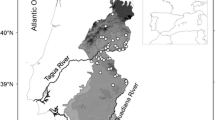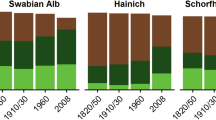Abstract
The preservation of the floristic diversity of natural ecosystems and the maintenance of extensive livestock grazing are two of the major priorities of European Union agricultural and environmental policies. Temperate natural and seminatural grasslands are among the most threatened ecosystems in Europe. In order to establish the most appropriate management practices that prevent degradation and maintain the richness of these ecosystems, detailed analyses of the mechanisms that regulate biodiversity of the communities are particularly necessary. In this study we make a comparative analysis of the species richness and the diversity of the main rangeland communities in a widespread, heterogeneous area located in the Western Spanish Pyrennees. The nature and the contribution of perennials and annuals to the diversity patterns encountered are studied and related to the mechanisms suggested to regulate diversity in each case. Higher diversity values were reported in more environmentally stressed, xeric and moist communities. High spatial and temporal heterogeneity and low rates of competitive displacement related to the scarcity of basic resources are among the factors suggested to regulate the diversity of these communities. In areas where environmental factors are more favorable, such as perennial-dominated mesic rangelands, the enhancement of the diversity seemed more dependent on biotic disturbances, such as herbivory, that decreased the cover of perennials and favored the recruitment of short-lived species. Dispersal processes related to traditional nomadic grazing allow a flow of species from one rangeland to another but also enhance the establishment of species coming from lowland habitats. Most of the annuals enhancing the diversity of the mesic community were ruderals. The consideration of ruderals as exotics or as species belonging to this grazing ecosystem poses an interesting, controversial topic related to the ecological quality of the diversity estimated for these communities.
Similar content being viewed by others
References
Allen TFH and Hoekstra TW (1992) The community criterion. In: Toward a Unified Ecology. Complexity in Ecological Systems series, pp 126–58. Columbia University Press, New York
Anon (1994) SPSS Advanced and Professional Statistics 6.1. SPSS Inc, Chicago
Aseginolaza C, Gömez-Garcia D, Lizaur D, Montserrat G, Morante G, Salaverria MR, Uribe-Echebarria PM and Alejandre JA (1984) Catàlogo florístico de Alava, Vizcaya y Guipùzcoa. Gobierno Vasco. Viceconsejeria de Medio Ambiente. Gasteiz
Begon M, Harper JL and Townsend CR (1988) Ecología. Individuos, poblaciones y comunidades. Ed Omega, Barcelona
Baldock D (1990) Possible policy options and their implication for conservation. In: Haggar RJ and Peel S (eds) Grassland Management and Nature Conservation. Occasion Symposium n. 28. BGS, Reading
Brown JH, Mehlman DW and Stevens GC (1995) Spatial variation in abundance. Ecology 76: 2028–2043
Burke IC, Lauenroth WK, Vinton MA, Hook PB, Kelly RH, Epstein HE, Aguiar MR, Robles MD, Aguilera MO, Murphy KL and Gill RA (1998) Plant-soil interactions in temperate grasslands. Biogeochemistry 42: 121–143
Canals RM (1997) Vegetation dynamics abd plant diversity patterns of disturbed grasslands and heathlands in Urbana-Andia Natural Park. Publications of PhD Thesis. UPNA, Pamplona
Canals RM and Sebastià MT (in press) Soil nutrient fluxes and vegetation changes following mole disturbances. Journal of Vegetation Science 11
Collins SL and Barber SC (1985) Effects of disturbance on diversity in mixed-grass prairie. Vegetatio 64: 87–94
Collins SL and Uno GE (1985) Seed predation, seed dispersal, and disturbance in grasslands: a comment. American Naturalist 125: 866–872
Collins SL and Glenn SM (1988) Disturbance and community structure in North American prairies. In: During HJ, Werger MJA and Willems JH (eds) Diversity and Pattern in Plant Communities, pp 131–143. SPB Academic Publishing, The Netherlands
Chapin FS and Körner C (1994) Arctic and alpine biodiversity: patterns, causes and ecosystem consequences. Trends in Ecology and Evolution 9: 45–47
Dean WRJ, Milton SJ and Klotz S (1997) The role of ant nest-mounds in maintaining small-scale patchiness in dry grasslands in Central Germany. Biodiversity and Conservation 6: 1293–1307
During HJ and Willems JH (1984) Diversity models applied to a chalk grassland. Vegetatio 57: 103–114
Fischer S and Stöcklin J (1997) Local extinctions of plants in remnants of extensively used calcareous grasslands 1950–1985. Conservation Biology 11: 727–737
Fowler N and Antonovics J (1981) Competition and coexistence in a North Carolina grassland: I Patterns in undisturbed vegetation. Journal of Ecology 69: 825–841
Glenn-Lewin DC and Ver Hoef JM (1988) Scale, pattern analysis, and species diversity in grasslands. In: During HJ, Werger MJA and Willems JH (eds) Diversity and Pattern in Plant Communities, pp 115–129. SPB Academic Publishing, The Netherlands
Grime JP (1973) Competitive exclusion in herbaceous vegetation. Nature 242: 344–347
Grubb PJ (1977) The maintenance of species richness in plant communities: the importance of the regeneration niche. Biological Review 52: 107–145
Grubb PJ (1986) Problems posed by sparse and patchily distributed species in species-rich plant communities. In: Diamond J and Case TJ (eds) Community Ecology, pp 207–225. Harper and Row, New York
Herben T, Krahulec F, Hadincova V and Skalova H (1993) Small-scale variability as a mechanism for large-scale stability in mountain grasslands. Journal of Vegetation Science 4: 163–170
Huston MA (1979) A general hypothesis of species diversity. American Naturalist 113: 81–101
Huston MA (1994) Biological Diversity. The Coexistence of Species on Changing Landscapes, Cambridge University Press, Cambridge
Janssens F, Peeters A, Tallowin JRB, Bakker JP, Bekker RM, Fillat F and Oomes MJM (1998) Relationship between soil chemical factors and grassland diversity. Plant and soil 202: 69–78
Levassor C, Ortega M and Peco B (1990) Seed bank dynamics of Mediterranean pastures subjected to mechanical disturbance. Journal of Vegetation Science 1: 339–344
Levin SA (1992) The problem of pattern and scale in ecology. Ecology 73: 1943–1967
Magurran AE (1989) Diversidad ecolögica y su mediciön. Ed Vedra, Barcelona
Malo JE and Suàrez F (1995) Herbivorous mammals as seed dispersers in Mediterranean dehesa. Oecologia 104: 246–255
Marañön T (1986) Plant species richness and canopy effect in the savanna-like “dehesa” of SW Spain. Ecologia Mediterranea 12: 131–141
Marañön T (1991) Diversidad en comunidades de pasto mediterraneo: modelos y mecanismos de coexistencia. Ecologia 5: 149–157
McIntyre S, Lavorel S and Tremont RM (1995) Plant life-history attributes: their relationship to disturbance response in herbaceous vegetation. Journal of Ecology 83: 31–44
Mc Neely JA (1994) Lessons from the past: forest and biodiversity. Biodiversity and Conservation 3: 3–20
Peet RK (1974) The measurement of species diversity. Annual Review of Ecology and Systematics 5: 285–307
Pineda FD, Nicolàs JP, Ruiz M, Peco B and Bernàldez FG (1981) Succession, diversitè et amplitude de niche dans les pâturages du centre de la Pèninsule Ibèrique. Vegetatio 47: 267–277
Poschlod P, Kiefer S, Traenkle U, Fischer S and Bonn S (1998) Species richness in calcareous grasslands is affected by dispersability in space and time. Applied Vegetation Science 1: 75–89
Puerto A, Rico M, Matías MD and García JA (1990) Variation in structure and diversity in Mediterranean grasslands related to trophic status and grazing intensity. Journal of Vegetation Science 1: 445–452
Quinos PM, Insausti P and Soriano A (1997) Facilitative effect of Lotus tenuis on Paspalum dilatatum in a lowland grassland of Argentina. Oecologia 114: 427–431
Ratcliffe DA (1986) Selection of important areas for wildlife conservation in Great Britain: the Nature Conservancy Council's approach. In: Usher MB (ed) Wildlife Conservation Evaluation, pp 136–159. Chapman & Hall, London
Ricklefs RE (1987) Community diversity: relative roles of local and regional processes. Science 235: 167–171
Scheiner SM (1992) Measuring pattern diversity. Ecology 73: 1860–1867
Sebastià MT (1991) Els prats subalpins prepirinencs i els factors ambientals. PhD Thesis. Barcelona University, Barcelona
Ter Heerdt GNJ, Bakker JP and De Leeuw J (1991) Seasonal and spatial variation in living and dead plant material in a grazed grassland as related to plant species diversity. Journal of Applied Ecology 28: 120–127
Tilman D (1982) Resource Competition and Community Structure. Princeton University Press, Princeton, New Jersey
Tilman D (1983) Plant succession and gopher disturbance along an experimental gradient. Oecologia 60: 285–292
Tilman D (1994) Competition and biodiversity in spatially structured habitats. Ecology 75: 2–16
Tilman D and El Haddi A (1992) Drought and biodiversity in grasslands. Oecologia 89: 257–264
Tilman D and Paccala S (1993) The maintenance of species richness in plant communities. In: Ricklefs RE and Schluter D (eds) Species diversity in ecological communities, pp 13–25. University of Chicago Press, Chicago
Van der Maarel E (1988a) Species diversity in plant communities in relation to structure and dynamics. In: During HJ, Werger MJA and Willems JH (eds) Diversity and Pattern in Plant Communities, pp 1–14. SPB Academic Publishing, The Netherlands
Van der Maarel E (1988b) Floristic diversity and guild structure in the grasslands of Öland's Stora Alvar. Acta Phytogeographica Sueca 76: 53–65
Van der Maarel E (1993) Plant species turnover and minimum area in a limestone grassland. Abstracta Botanica 17: 173–178
Waser NM and Price MV (1981) Effects of grazing on diversity of annual plants in the Sonoran desert. Oecologia 50: 407–411
Wheeler BD and Shaw SC (1991) Above-ground crop mass and species richness of the principal types of herbaceous rich-fen vegetation of lowland England and Wales. Journal of Ecology 79: 285–301
Whittaker RH (1965) Dominance and diversity in land plant communities. Science 147: 250–260
Willems JH, Peet RK and Bik L (1993) Changes in chalk-grassland structure and species richness resulting from selective nutrient additions. Journal of Vegetation Science 4: 203–212
Wiens JA, Addicott JF, Case TJ and Diamond J (1986) The importance of spatial and temporal scale in ecological investigations. In: Diamond J and Case TJ (eds) Community Ecology, pp 145–153. Harper and Row Publishers, New York
Zobel M, Moora M and Haukioja E (1997) Plant coexistence in the interactive environment: arbuscular mycorrhiza should not be out of mind. Oikos 7: 202–208
Zobel M, Van der Maarel E and Dupre C (1998) Species pool: the concept, its determination and significance for community restoration. Applied Vegetation Science 1: 55–66
Author information
Authors and Affiliations
Rights and permissions
About this article
Cite this article
Canals, RM., Sebastià, MT. Analyzing mechanisms regulating diversity in rangelands through comparative studies: a case in the southwestern Pyrennees. Biodiversity and Conservation 9, 965–984 (2000). https://doi.org/10.1023/A:1008967903169
Issue Date:
DOI: https://doi.org/10.1023/A:1008967903169




